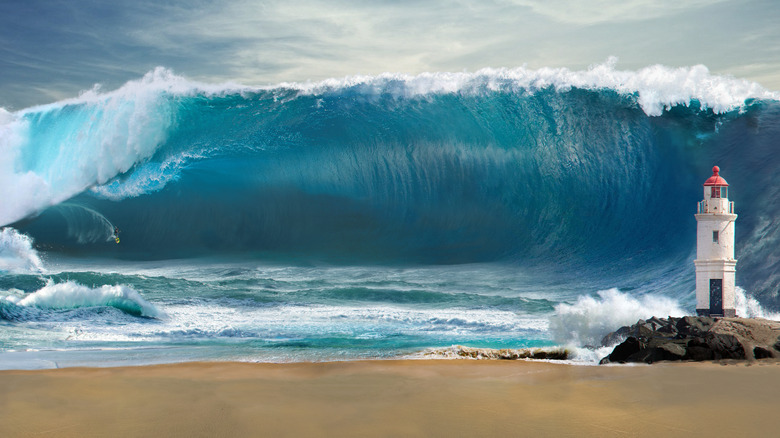The Alarming Speed Of The Average Tsunami
Humankind could certainly be accused of being more than a little complacent in the face of nature at times. In the day-to-day comings and goings of our lives, it's easy to think that our jobs, social lives, bank balances, and errands are super significant. In the end, though, we're just another of the approximately 8.7 million species fortunate enough to live on this wonderful planet (per World Atlas) .
It's quite remarkable that Earth is able to support its many residents in the first place. As NASA reports, the planet is perfectly positioned in what has been deemed a 'Goldilocks Zone' in space, meaning that conditions aren't too harsh in terms of heat, cold or any other variables for an enormous variety of species to thrive. This zone became ever bigger over the years, NASA goes on, as new 'impossible' species were discovered, but the point remains: we're very lucky indeed. For the most part.
The fact is, though, Earth isn't a calm, blissful safe-haven. Seismic activity leaves us vulnerable to a range of natural disasters, from volcanoes to earthquakes. As the National Ocean Service reports, tsunamis can be caused by either of these, and their devastating, terrible power is awful to behold. It's little wonder, when you consider the incredible speeds the average tsunami can reach.
A slow and steady build of power
According to Science Focus, a tsunami begins to form when such seismic activity displaces the water above the ocean floor. The wave generated appears very modest at first, perhaps just 30 centimeters high. The highest tsunami runup ever recorded, for comparison, reached a staggering 1720 feet, per Geology. It was the result of an earthquake throwing a huge weight of rock from a height of 3000 feet into Lituya Bay, Alaska, on July, 9 1958.
The National Weather Service explains that tsunami waves have very different properties to regular waves caused by winds. They move across the whole ocean, rather than just the surface, and while at a distance from land they remain modest in height (around three feet high). Their speed, apparently, is affected by the depth of the water they're traveling through: deep in the ocean, a tsunami moves at up to 500mph, a staggering pace matching that of jet aircraft.
Mercifully, per Science Focus, the force of friction acting on the waves as the water gets shallower slows them significantly as they approach land. This same effect, however, causes a buildup of water that makes the waves much higher.

